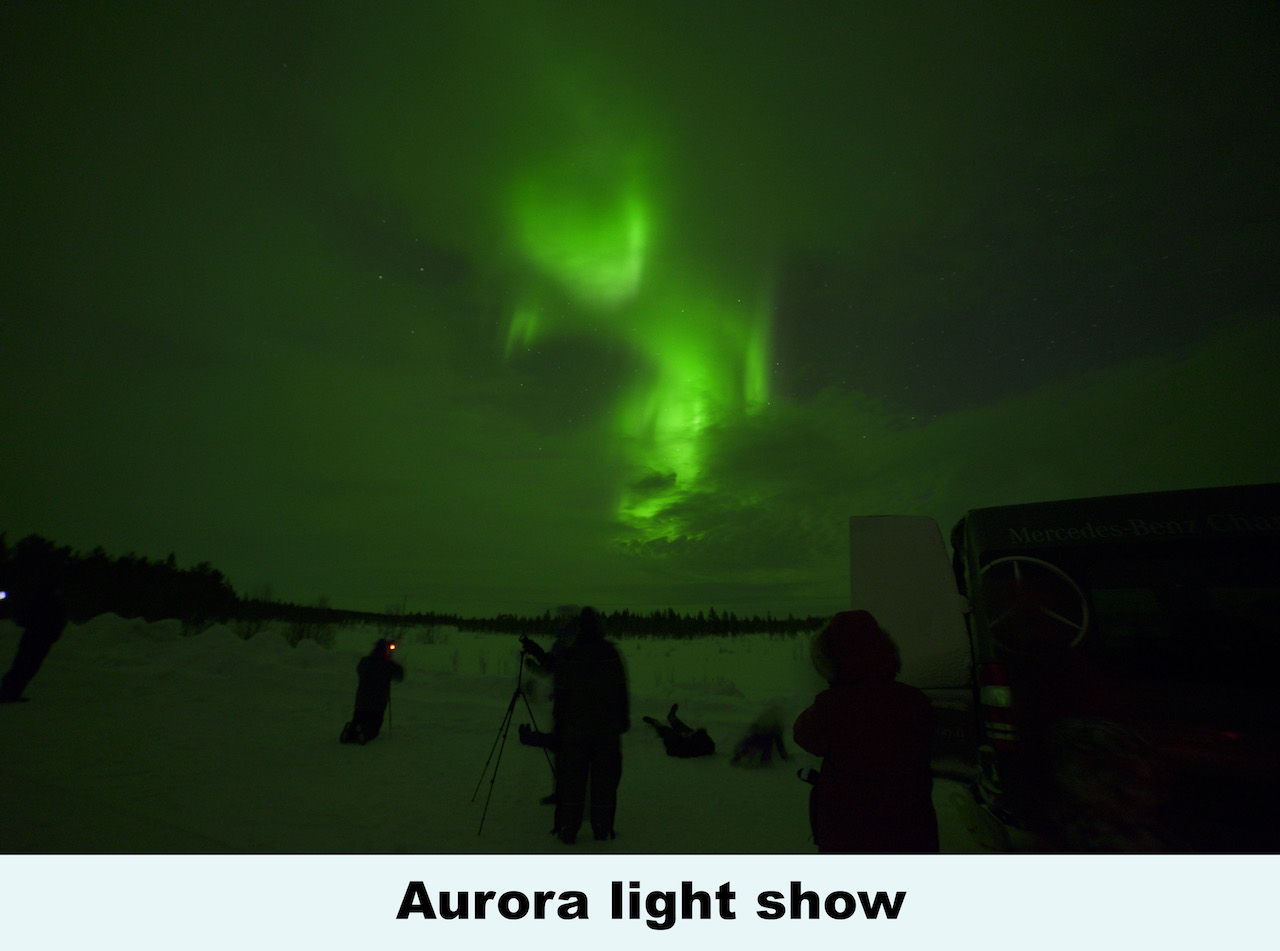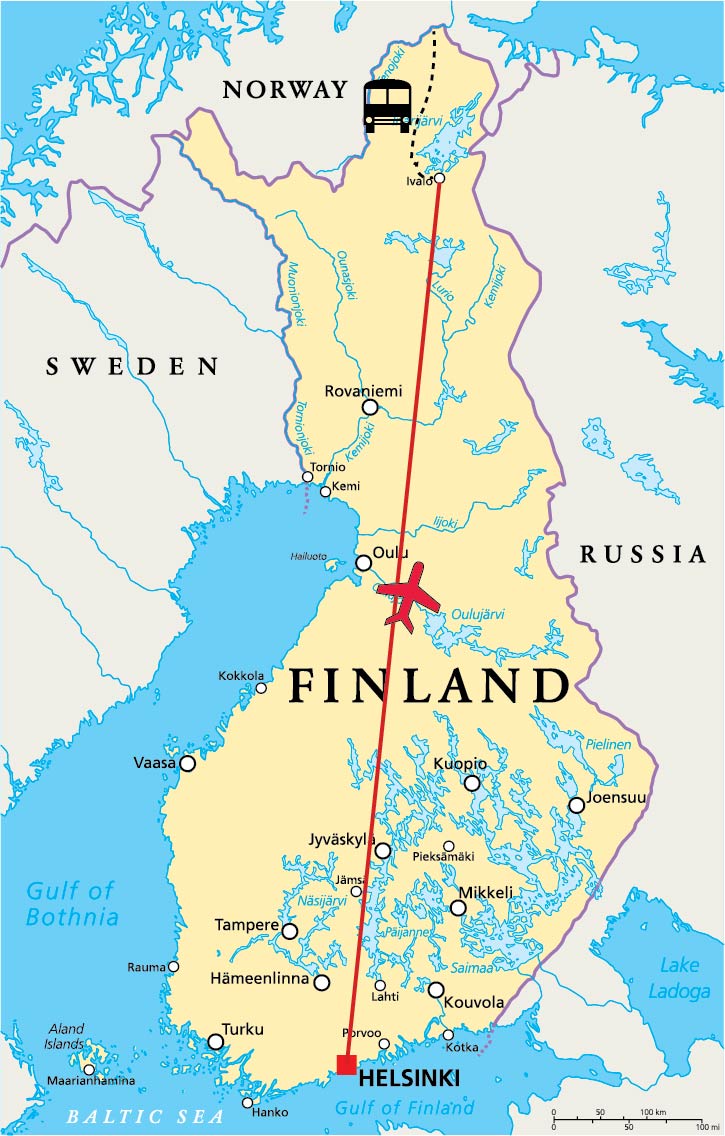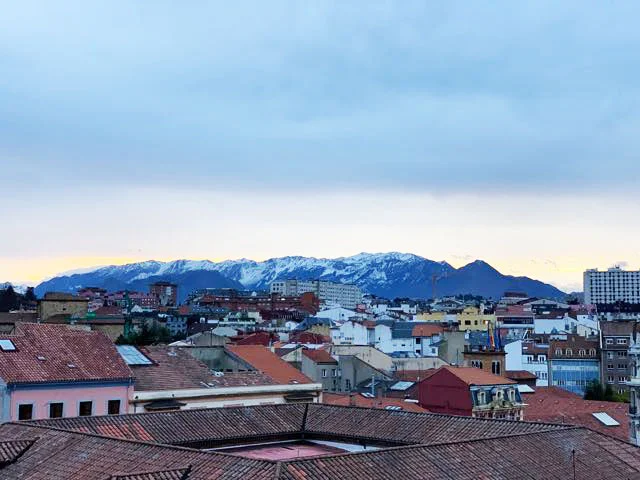Chasing Northern Lights across Finnish Lapland
by Elyn Aviva
“I feel way out on the edge. The far edge,” my husband, Gary, told me, his voice vibrating with a bit of trepidation. He continued, “We’re north of the Arctic Circle. A long way north!”
I looked around. We were sitting in a comfortable Mercedes minibus, along with 12 other people, traveling to our aurora-hunting base in the far north of Finnish Lapland. Snow blanketed the low, sloping hills, their unsullied whiteness punctuated by dark exclamations of leafless birch trees and slightly swaying dark green spruce. A thin powerline drifted across the sky, and suddenly two dappled brown reindeer ambled across the road.
We were spending five days (four nights) on a dedicated aurora-sighting tour. We had flown an hour north from Helsinki to the furthest-north Finnish airport, Ivalo, and now we were being transported two hours further north by minibus on Highway 4, the only highway in this part of Finland. Our guide, Daniel, was driving with great care (the roads were icy and a light rain dampened the windshield) to our seven-cabin base “camp” outside the small town of Utsjoki.
We had stopped at a supermarket to purchase supplies for the four days we would be staying there. During the day, Daniel would pick up members of the group who wanted to go snowmobiling, snow-shoeing, or dog-sledding, and each night he would come to take us aurora hunting.
“Out on the edge?” It didn’t feel like that to me. I felt comfortable, at home—as excited as a kid let out of school early. I was hoping to fulfill a dream: to see the aurora borealis dance across the sky.
I looked through the minibus window, enjoying the deep serenity of white and dark passing by, the clarity of the shifting monochromatic landscape. I realized how much I had missed winter. Not the superficial pseudo-season called “winter” in Girona, Catalonia, where temps might fall to freezing, but only momentarily, before rising to a balmy 45-50°F, and where even a sprinkling of snow is a rarity. That’s not really winter, just like instant coffee isn’t really coffee.
I grew up in the midwestern US and have lived in Colorado and northern New Mexico. Winter, to me, means cold, deep snow, and a time of rest. A time of being, not doing—a time when you don’t have to create or generate something new; a time of no sprouts pushing through the ground, no buds needing to grow. It’s a time to hibernate, gestate, huddle in front of a fire with a cup of hot chai or a steaming mug of soup—it’s a time to rest and prepare, not a time to put out and produce. I sighed happily, feeling myself slowing down inside.
It was dark by the time we arrived at the seven cabins, unloaded our suitcases, and settled into our attractive temporary home, complete with natural wood walls and reindeer-antler décor, electric heat, private sauna, and internet. Daniel explained that each cabin has an “aurora alert” cellphone, and if anything showed up that first night in the sky overhead, he would send a text alert and we could go out to see the Northern Lights. Overhead. Wow.
Of course, there was no assurance we would see the Northern Lights during our four nights above the 70° latitude, although the further north you go, the greater the likelihood. Aurora borealis are the result of the collision of electrically charged particles emitted by the sun (think: solar flares, solar storms) with gaseous particles in the Earth’s atmosphere. The colors (green, pink, blue, etc.) depend on what type of gas particles (oxygen, nitrogen) are colliding and where. For us to see the aurora would require the proper atmospheric conditions—not too much moonlight, not too many clouds, and enough solar action. There was no guarantee.
When the “aurora alert” sounded on the cabin’s cell phone that first night, we excitedly pulled on our multiple layers of winter clothing and ran out the door, looking eagerly into the sky, expecting to see green, shimmering curtains of light dancing across the stars, just like in the photos. We saw nothing except blurry stars and what looked like some pale clouds—or was that light from Utsjoki?
We retreated into the cabin, stripped off our insulating layers, and relaxed. Half an hour later, the “aurora alert” sounded again, and again we dashed into our clothes and outside. Again nothing—or maybe that faint white glow was an aurora? By the third alarm (perhaps it was a false alarm?), Gary gave up dashing outside, though I continued, without any success. After all, this might be my only opportunity to see the lights, and we had come so far just for this.
I realized I didn’t know what to look for, or where to look, so although it was 10:45 p.m., I called the Aurora Service Tours number, planning to leave a message. Piritta, the manager, answered (she assured me that during the season, she rarely slept) and told me that the aurora that night were very faint and brief, lasting perhaps five minutes. She also told me where to look—in the north, northwest, near the horizon. Now I knew. The last aurora alert was at 12:45 a.m. and I ran outside without putting on my parka or ski pants, but I still saw nothing. Fortunately, we had three more nights of possibility.
We had better luck the second night. Daniel came around 8 p.m. and set up his camera tripod in the middle of the snow-packed drive that passed in front of the seven cabins. The clouds dissipated, and soon we were treated to an amazing display of flickering curtains of lights, shooting streaks, arches, and swirling twirling shapes. They danced, they pranced, they flashed overhead, faintly veiling some of the stars and a section of the Milky Way.
They were astounding. But I was surprised by one thing: they were white. I looked at Daniel’s LCD viewfinder and the aurora was glowing lime green. I looked up into the sky, and they were white. Head down to look at viewfinder: chartreuse; head up to look at the sky: white. My head bobbed up and down like a wobble-headed toy. Green, white; white, green. The aurora appeared to be green in the viewfinder—but they didn’t look green to me. They looked white. Was the brilliant color a trick of the camera lens?
Daniel explained that unless the aurora were very strong (and these were weak to medium), the human eye can’t register their color. Our eyes have both cones and rods: rods see in low light but no color; cones see color but aren’t activated unless there is enough light. That night, there wasn’t and they weren’t. So we saw a display of pale white light shifting and swirling across the night sky, while the camera “saw” bright lime green because it was set for long exposure and has a more sensitive “eye.” It wasn’t a trick, it was technology.
I felt an uncomfortable mixture of gratitude, disappointment, and guilt. After all, we had just seen the aurora—lots of them, for hours, as they paraded across the sky. My dream had come true. I was filled with gratitude. But they weren’t quite what I had expected. They were white. I felt let down.
The next night, Daniel drove our group almost 70 miles south on snow-packed roads to find a break in the dense cloud cover. He told us we would meet up with another Aurora Service Tour driver/guide who was frantically searching for aurora to show his group. They were based at another “camp,” and the previous night the cloud cover had never lifted. We rendezvoused, waiting a few minutes, and the clouds parted and the aurora put on a glorious show. We had seen them for two nights in a row. What great fortune!
And yet. And yet. They were white, not green unless I looked at the camera viewfinder. The photos that Daniel took and gave to us captured those moments of exquisite, unearthly beauty—but the full-color beauty of the aurora had only been visible to the camera. What was the “real” color of the aurora, I wondered: what my eyes saw or what the camera “saw”?
In the pale white stillness of the Lapland winter, I was reminded of the Zen koan: If a tree falls in the forest and no one hears it, does it make a sound?
Elyn Aviva is a transformational traveler, writer, and fiber artist who lives in Girona, Spain. She is co-author with her husband, Gary White, of “Powerful Places Guidebooks.” To learn more about her publications, go to www.powerfulplaces.com and www.pilgrimsprocess.com. To learn about Elyn’s fiber art, go to www.fiberalchemy.com. Gary’s blog about their expat life is www.fandangolife.com.










